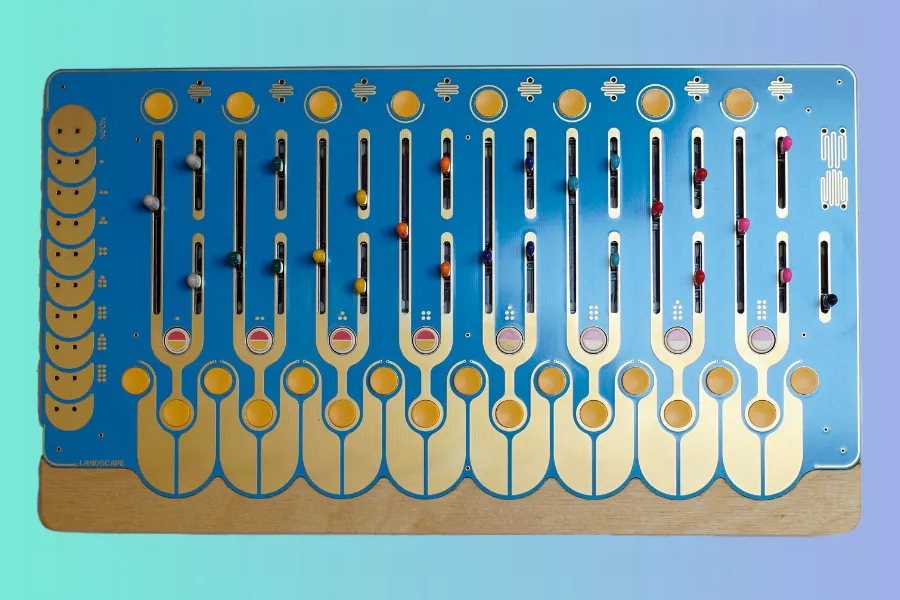3. January 2022 | Hardware | Noizefield
Landscape announced Noon

Landscape announced Noon, a passive analog drum/synthesizer. Each of the eight channels uses a unique analog circuit with its own characteristics. No power supply is needed. Each circuit is triggered and powered individually from incoming gates or control voltages provided by voltage sequencers or modular systems. By using this unique method, we can increase instability and magnify organic aspects of traditional analog electronic instruments. The sound of analog, at its core, is the sound of sculpted electricity. By removing the stabilizing elements of a constant power source, we can listen to the sound of electronic circuits loading and unloading, powering up and powering down, and we can increase the natural chaotic movement of electricity. The loading of circuits creates natural ways to access swing and groove or ways to deconstruct a programmed rhythm sequence to make surprisingly new ideas.
Each channel is represented by a tuning fork. Incoming voltage can be thought of as a way to “strike” each fork with momentary voltage. Between every channel there are Link buttons which allow voltage sharing between channels. Linking them provides a wide mix of results depending on incoming voltage, active or inactive channels, slider settings, gate lengths and multichannel linking. The results can be described as cross modulation, growth (creating a larger and more complex circuit), or processing (filtering, distortion). Due to the cycles of voltage and this inherent instability, a definition of what is actually occurring between channels can be hard to pin down. The eight Mod buttons, which are located at the bottom of each tuning fork, change the behavior and sound of each circuit. The eight latching CV buttons along the top allow the “☾” Even and “❍” Odd CV modulation inputs to route to even and odd channels. When incoming CV is unmuted, a channel’s behavior can change drastically and this behavior can change further when channels are linked. These CV inputs are a way to add microtonal pitch changes and/or large textural movement to voices. The Even and Odd CV inputs are summed to their respective channels to provide a rhythmic modulation reference between multiple channels.
Features:
- Each channel has dynamic and organic response to different gate lengths
- Each of the channels feature a unique analog circuit which is powered and controlled directly from its gate input.
- Each channel has a latching Mod button which changes the sound and response of the channel.
- Each channel can be treated as a “drum voice” or a “synth voice” but more likely somewhere in between.
- Eight CV Mute buttons allowing for muting or unmuting of incoming CV from the Even or Odd CV inputs.
- Even/Odd CV Inputs are a summed to even and odd channels respectively when CV Mutes are unmuted.
- Each channel can link to the neighboring channel via a link button. The two link buttons at either end (of channels 1 and 8) allow the channel links to wrap back around, 1 → 8 or 8 → 1
- All eight Gate Inputs can be powered by control voltages of any kind for widely varying results.
- Individual output per channel.
- Individual volume control per channel.
- When an individual output is used, the channel will be removed from the main outputs.
- Main Even & Odd channel outputs with a singular volume control. Even and odd channels are summed to these two outs.
- The Even Output normals to a mono mix of all 8 channels when no plug is present in the Odd Output.
- If using the main outputs while Channel Link buttons are engaged, strange stereo-esk imaging can occur because of shared characteristics and cross talk created by modulation and voltage sharing of Even & Odd Channels.
- The passive mix of the main outputs can create competition between channels resulting in compression effects.
- When a channel is treated as a “synth voice” incoming CV will not create a volts per octave or a 12 tone response. Instead expect microtonalities and (at times) large shifts in texture from note to note. Each channel will track pitch differently based upon its slider settings.
- When utilizing incoming CV along with gate signals a singular voice can at times achieve the illusion of multiple rhythm elements.
- Voices can achieve somewhat normal analog rhythm machine sounds when fed short gates or triggers.
- Varying gate length sequences can achieve movement and textural complexity normally associated with modular instruments and feedback patching.
- An external Audio Input is activated via the DOT/DUAL link button. This allows the link button to behave as a mute for incoming audio. External audio will mainly feed into the DUAL channel which can behave as a chaotic filter-feedback-distortion-vca type effect. The rhythm and tonality of the effect will vary greatly depending upon what method or methods of voltage you’re sending to DUAL and to a lesser extent DOT.
- In additional to being processed, the external audio can at times behave as a modulation source due to the additional voltage fluctuations provided by said audio.
- The Audio Input can be used to feedback any channel into channel 2/Dual.
- Each of the eight dual color Mute buttons will illuminate when a gate or voltage is received. When active it will illuminate yellow and when muted it will illuminate red. The intensity of illumination will changed based upon how much voltage is being received.
- The eight Mute buttons are post gate inputs which allow the channel to continue to effect or voltage share with a neighboring channel while they are linked.
- Eight pairs of 16 Touch Plates. Results vary based upon incoming voltages and control settings.
- One audio touch point per channel and main outs.
- The vertical row of CV/Gate input touch plates add the possibility to intermingle incoming voltages and rhythms across channel touch plates (results vary based upon incoming voltages).
- Active CV inputs can engage drone behavior in some channels, this drone behavior can grow in texture, movement and complexity as Link buttons are engaged. Use CV mute buttons along the top row to turn CV on or off.
- Interplay between linked channels can vary widely based upon how they are being activated, their slider settings, and at what intervals.
- When linked, powered channels will sometimes share voltage and thus partially activate unpowered channels. In this way, linking to unpowered channels can provide changes/modulation to the powered channel.
- Linked channels can be mutually responsive creating movement and modulation between one another or, depending on use, become more than one directional. For example, one voice may simultaneously be acting as an independent drum sound and a bubbling filter, feedback or distortion in the next instance “processing” its neighboring channel. At times the “processing” aspects from one channel will coincide with the modulation of another. In this way the two channels can become intermingled and contain both rhythmic and textural similarities of each other.
- At their most extreme settings voices can emit pops, clicks and random noise allowing you to sequence sounds normally associated with malfunctioning electronics.
Price
Late January 2022 / Price TBD
More info here: Landscape | Noon
HIT OR SHIT Indicator
Average Indication by Readers
What do you think?
Hit or Shit? Please rate from 1 (💩) to 10 (🚀)




